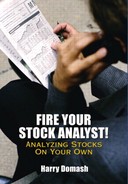Does Low Valuation Equal Low Risk?
Several academic studies found that portfolios made up of low valuation stocks, say those with low P/E ratios, outperformed high valuation portfolios over various time frames. In other words, value-priced stocks outperform growth stocks. That sounds like news that you can use, but when you delve into the details, you'll find that just a few stocks account for the value portfolio's outperformance. It turns out that most stocks making up those portfolios actually lost money.
To illustrate that phenomenon, I made up a portfolio of deep-value stocks. These were stocks that as of February 2001 had price/book ratios between 0.1 and 0.5. I call them deep-value stocks because usually a price/book ratio below 1.0 is enough to qualify a stock as value-priced. A total of 501 stocks met my deep-value requirements.
I measured the performance of my deep-value portfolio between February 2001 and February 2002. It returned 3 percent over the 52 weeks. That was a good return considering that the market as measured by the S&P 500 dropped around 12 percent during the period.
But when I looked at the results in detail, I found that a few outsized performers skewed the returns. For example, excluding just the top 10 performers would have turned the 3 percent gain into a 6 percent loss.
The same effect worked in reverse. Removing the ten biggest losers increased the portfolio return to 5.1 percent. Unless you bought all 501 stocks, you could have made money, or you could have lost money, depending on the particular stocks you picked.
I've done many similar tests in my search for the magic formula that would routinely turn up a list of market-beating stocks at the push of a button. Whenever I thought I'd uncovered the Holy Grail, it always turned out that a few stocks powered the portfolio's returns.
